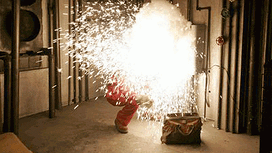What is “Arc Flash?”
Arc flash is a phenomenon that results from an arcing fault, where an electric current strays from its intended path and travels through the air causing an electrical explosion. Between the instantaneous explosion and the resulting radiation and shrapnel, an arc flash often causes violent and serious results;
 Severe skin burns
Severe skin burns- Respiratory system damage
- Hearing damage
- Eye/face injuries
- Even death
What Causes Arc Flash?
- Dust
- Sparks from dropping tools (Unless you use intrinsically safe tools *cough cough*)
- Accidental touching
- Condensation
- Material failure
- Corrosion
- Faulty installation
How Bad Can It Be?
Arc flash exposure is of a violent nature. It causes serious injury and in some cases even death. Some injured employees never regain their past quality of life. Medical care is quite costly, sometimes in excess of $1,000,000. Here are the typical results from an arc flash:
- Burns (especially non-fire retardant clothing, as it may burn onto your skin)
- Fire (possibility of it spreading throughout the building)
- Projectiles (molten metal, about 1,900 degrees F)
- Blast pressure (roughly equivalent to a Volkswagen Beetle hitting your body instantly)
- Sound blast (think about a gun being shot right next to your ears/face)
- Heat (About 4 times the surface of the sun)
This is a great segue into burns. Most of us have had a sunburn or two, but do you know what a third degree burn is? More importantly, do you know what to do in a situation where you or someone you know has been burned? Remember, the three goals of treating burns, no matter what degree, are to 1.) Prevent shock, 2.) Ease pain, 3.) Reduce the risk of infection. Let’s now talk about how to treat burns at each degree.
First degree burn:
- Red and sensitive to touch
- Minimal skin damage, only to outer layer (epidermis)
- Causes pain, redness swelling
- Example: Sunburn
 Second degree burn:
Second degree burn:
- Skin reddens intensively and blisters
- Damage to both outer skin and second layer (epidermis and dermis)
- Causes severe pain, redness, swelling, blistering and chance for infection
- Example: Steam burn or chemical burn
Third degree burn:
- Charring of skin (leathery), chest pains, rapid heartbeat/breathing
- Damage extends deeper into tissues (epidermis, dermis, and hypodermis)
- Causes extensive tissue destruction, may numb skin, and extensive scarring usually results
- Example: Fire, explosive or electrical burn
Treatments of burns, by level:
- First degree
- Hold under cold water for a couple of minutes
- Apply ointment/burn cream
- Wrap with sterile gauze
- Take a pain reliever (aspirin, ibuprofen, acetaminophen), if necessary
- Second degree
- Cool the burn (cold water; 10 minutes); if blisters are open, do not apply water!
- Do not apply burn cream or ointment. Though, you should wrap in a sterile gauze bandage
- Seek medical attention
- Third degree
- This requires immediate medical attention
- Third degree burns may require hospitalization (burn unit)
***Remember, never use ice on a burn. It prevents healing by decreasing blood flow and causing a person’s body to become too cold and can cause further damage to the wound.
Ways to Protect Yourself and Your Workers
The good news about arc flash is that there are a number of ways of protecting yourself from the threat of these hazards. In fact, the most effective and fool-proof way to eliminate the risk of electrical shock or arc flash is to simply de-energize the equipment. Here are a few other ways:
 Safe work practices
Safe work practices- Insulation
- Guarding
- Barricades
- Ground Fault Circuit Interrupters (GFCI)
- Grounding (secondary protection)
Remember, personal protective equipment (PPE) is the last line of defense. PPE cannot prevent all injuries and will only lessen the impact of an arc flash. In many cases, the use of PPE has saved lives or prevented serious injuries so don’t neglect it!
Only qualified persons (one who has received proper training) should work on or near circuits. If you have any questions regarding arc flash, leave a comment or contact STS directly at Contact STS. If you are looking for an NFPA 70E “Arc Flash” course, click the button below to find out how you can become a qualified person through Safety Training Services, Inc.

